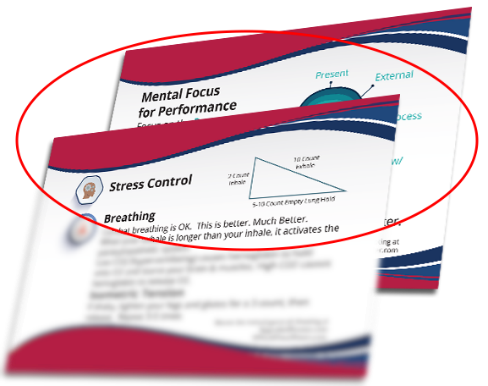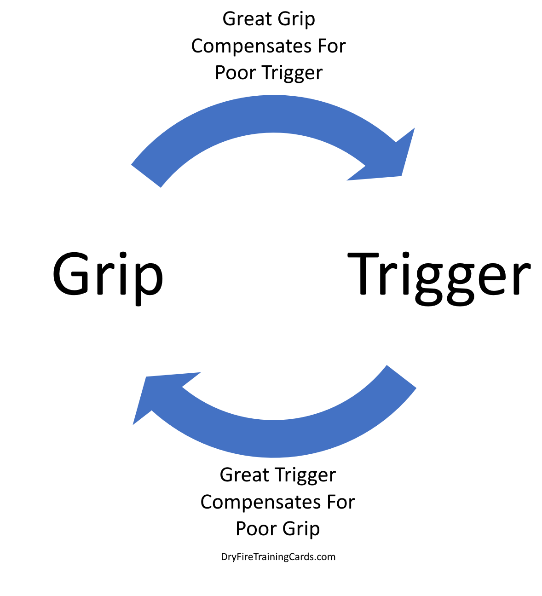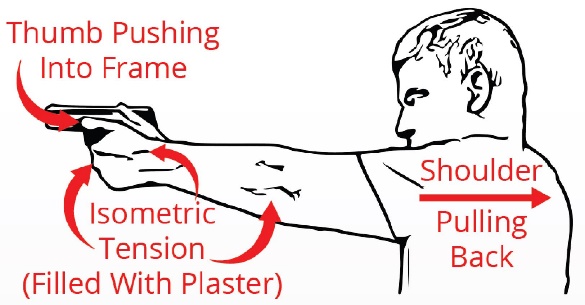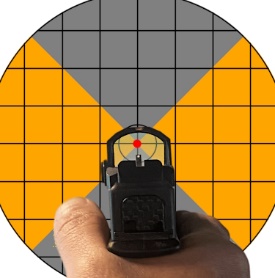Next time you’re at the range shooting a pistol and you’re not hitting where you want or as tight of groups as you want, what can you do—RIGHT NOW—to shoot better with your very next shots?
Even if you’re shooting the dreaded low-left groups (or low-right for right handers).
Or if you’re flinching in anticipation—even if you love shooting.
I don’t mean things that you can do to shoot better later today, tomorrow, or next week, but how can you shoot better in the next couple of minutes?
#1 Breathe. One of the most common issues that shooters have is flinching because of anticipating recoil. You may love shooting, but your brain isn’t real happy about little explosions happening 18” from your face.
Breathing is one of the quickest ways we can calm the brain down, and this method of breathing is the quickest and most effective according to a recent study. It’s called Triangle Breathing.

What you want to do is breathe in quickly and sharply through your nose for a 2-count, breathe out slowly through your mouth for a 10 count, and then hold your breath with empty lungs for a 5-10 count and repeat a couple of times.
This will calm your brain and get it out of fight-or-flight mode so you are less likely to flinch.
It can also cause a racing heart to slow down 30 or more beats per minute in 10-20 seconds. (You won’t see it this fast on a wrist heartrate monitor because those results are averaged and have about a 30 second lag, but you can see it as it’s happening with a chest strap.)

#2 Grip. I can do a whole course on grip, but here’s a drive-by guide to grip. Grip the pistol with your shooting hand with the intensity of a firm handshake. Not too firm, or you won’t be able to move your trigger finger without disturbing the sights.

Pistol support grip technique to help with the worst trigger press
With your support hand, pull straight back against your shooting hand.
**Here’s the secret sauce** Press your support thumb directly into the frame of your pistol.
That will create a little twist on the gun that you’ll automatically counter with your shooting hand.
This combination of forces makes it way easier to press the trigger without having the sights move…regardless of where you’re finger is at on the trigger.
If the sights are moving as you’re pressing the trigger, loosen your shooting hand grip and let your support hand do most of the work.
#3 Trigger. You can pretty much forget about taking up the slack, the wall, and everything else like that if you do what I’m about to tell you.
Touch the trigger with your trigger finger with your sights on your intended target.
Imagine what applying 1lb of pressure to the trigger would feel like, and do it. That’s going to take up the slack and get you to a point where the trigger resistance increases (the wall).
Now, imagine what 2lb of pressure on the trigger would feel like, and do it at whatever speed you can and still keep your sights on the target. 
Then 3, then 4, then 5, etc.
It doesn’t matter when, but at some point, the gun is going to release the shot. It could be when you hit 3 or it could be when you hit 13. It doesn’t matter. What matters is that you’re gradually increasing pressure on the trigger.
It also doesn’t matter if the gun releases the shot on “9” with your first shot, “3” on your 2nd, and “6” on your 3rd. Counting is simply a tool to occupy your mind and develop the ability to press the trigger without disturbing the sights.
The weaker your grip and the heavier the trigger, the harder it will be to go slow…so if you’re having problems with a gun with a heavy trigger, switch to a gun with a lighter trigger until you’ve got this mastered.
The speed that you can increase pressure on the trigger without disturbing the sights will be slow at first and speed up over time.
A GREAT tool for speeding up your trigger press is a metronome app on your phone.
You can set it to 60 beats per minute and increase trigger finger pressure by a pound every time you hear a beep.
Then 90 beats per minute, and 120, and 180, until you don’t need the metronome and can quickly and effortlessly press the trigger as fast as you want without disturbing the sights.
Use these techniques to get instant results and practice them to make them permanent so you can automatically use them under stress.
There are two extremes of pistol shooting…
First is range shooting and plinking, where the focus is on perfect form, stance, breathing, and a slow, gentle trigger press. Standing and shooting targets at the range in sterile, controlled conditions is an example.
Second is reality based shooting, where the focus is delivering effective hits as quickly as possible in a surprise, chaotic, stressfull situation where you don’t have time for a perfect stance, and need to stop the threat faster than a slow, gentle trigger press allows. Competition shooting and shooting to save a life is an example.
They’re 2 different animals.
And sterile range shooting doesn’t get people ready for real world shooting.
But >This training< does.
I’ve got a free 1-hour video presentation I’d like to share with you where I’ll tell you how to make the jump from sterile range training to training to fight with a gun in a real world self-defense situation. I recorded it and you can watch it for another day or so >HERE< right now.
Leave A Response